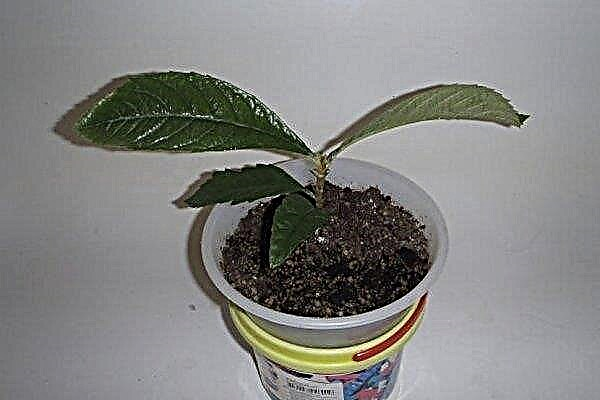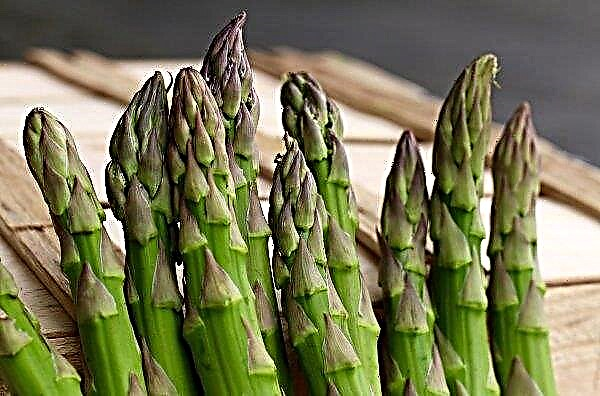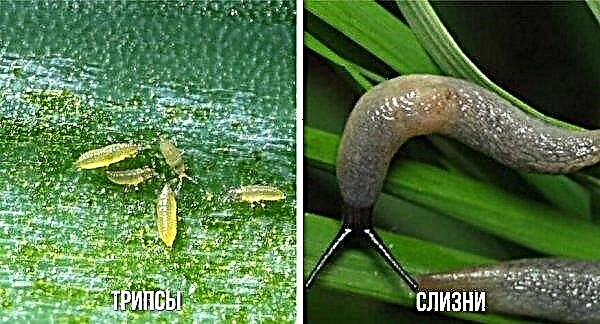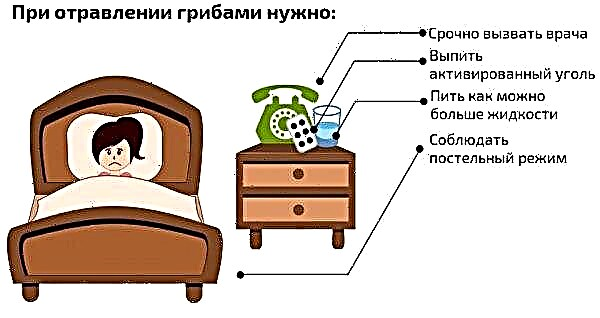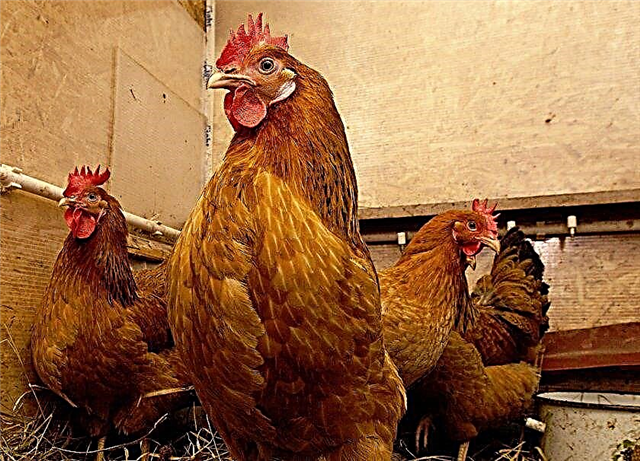Thanks to the selection work, the rows of indoor violets are replenished with new, unusual specimens. One of these varieties is the violet Ballerina, which is described in detail in this article.
Botanical description of the plant
The ballerina forms a dense basal rosette of elastic leaves from 20 cm to 40 cm high. The leaf plate is dark green in color, oval in shape, with a wavy edge. A young plant blooms about a year after planting. In the spring, long peduncles appear with numerous buds.
Did you know? Violets were the favorite flowers of Josephine Beauharnais, the French Empress, she pinned a bouquet of flowers to the dress, decorated the rooms with them.
This variety has virtually no breaks in flowering: as soon as one peduncle fades, the next leaves appear in new leaves. In this case, the flowers last about 2 months. The exception is winter, a relative period of rest. Large terry baskets up to 7 cm in diameter are painted white. Petals are arranged in several rows, the middle of the flower is yellow.
Conditions for successful growing at home
Violets are, in principle, unpretentious plants, it is not difficult for them to create the necessary temperature regime and humidity.
Placement and lighting
Saintpaulia (the second name of room violet) RS-Ballerina is the owner of dark leaves. Such varieties are placed on window sills closer to the glass, on shelves - in the first row from the lamp. If the windowsills are southern, it is advisable to shade them from the direct rays of the sun, for example, with thick white paper. In winter, flowers will need to extend daylight hours; the best option for backlighting is a fluorescent lamp. Daylight hours should last at least 10 hours.
Did you know? According to Christian myths, violets grew from the tears of Adam, to whom the archangel Gabriel brought the news of the forgiveness of sins.
Temperature and humidity
The most comfortable temperature is + 20 ... + 22 ° С; night temperature can drop to + 19 ° С. Sudden changes, drafts can lead to diseases and the death of the pot. The optimal value of air humidity is 50-60%. In winter, during the operation of heating appliances, the air in apartments and houses is overdried. So that the violet does not suffer from this, place a tray with wet expanded clay or moss near the pot. The microclimate around the plant will be what it needs.
How to care at home
The development and duration of flowering of the bush depends on the quality care of the senpolia.
Important! Spraying the bush is not recommended: pubescent leaves delay droplets of water, increasing the risk of fungal diseases.
Watering
For watering the flower, water with a temperature of + 20 ° С is used for at least 24 hours. Since the bush forms a dense rosette, the upper watering will be inconvenient. It is better in this case to apply watering through a pallet. Water is poured in small portions, then left for 10-15 minutes, the remaining water is drained. The frequency of watering will depend on the degree of drying of the topsoil of 1.5 cm.
Fertilizer application
Long-blooming violets need to constantly replenish the supply of nutrients, so plants are fed 2 times a month. Balanced mineral complexes are used, for example, "Bona Forte for violets and begonias." According to the instructions for root dressing, you need to dilute 10 ml / 1.5 l of water. Experienced growers recommend halving the dosage from the manufacturer.
Important! Do not fertilize a diseased plant if the disease is not caused by malnutrition.
Transfer
Every year in the spring, the bush requires updating the soil. The plant is removed from the old tank by tapping on the edges. Gently shake off the adhering soil, if there are signs of oxidation, it is better to rinse the roots with water and dry them before replanting. Too long or sick, damaged roots are trimmed, sections are sprinkled with crushed activated carbon.
The surface root system of the plant is not inclined to grow strongly in volume or in depth: as the bush grows, the old roots die off, and new ones form above the soil surface under the lower leaves, so a new pot needs no more than 10 cm in volume and the same height.
To prepare the soil mixture you will need the following components:
- garden land - 2 parts;
- perlite - 2 parts;
- river sand - 1 part;
- peat - 1 part.
Transplant Technology:
- 2-3 cm of drainage is placed in the pot (large pebbles, expanded clay).
- A bush is laid on a hill of soil, spreading its roots.
- The bush is deepened along the bottom row of leaves and watered.
- If within 2 weeks the plant throws the peduncles, it is better to cut them off, since the root system has not yet adapted sufficiently.
How to breed at home
The variety propagates vegetatively: leafy cuttings or the so-called baby. You can buy planting material in online stores for flower growers.
Cuttings
As a handle, a leaf is taken, elastic and healthy, preferably from the middle row of the outlet.
Sequencing:
- Cuttings are cut at an angle of 40–45 °.
- Place in a container (plastic cup) with water, stirring a tablet of coal in it.
- Cover the container with a greenhouse.
- After the appearance of the roots, they are transplanted into a pot with soil.
Video: propagation of violets by cuttings
Kids
Children can be raised from a rooted leaf. The approximate period of appearance is 2-6 months.
Technology:
- A young bush is carefully thrown out of the tank.
- Separate the baby with its own root system and at least two leaves.
- Transplanted into a small to 5-6 cm tall pot.
Video: violet propagation by children
Growing difficulties
Diseases and pest attacks are easier to prevent with preventative measures. One of them is disinfection of the soil during planting, for example, by calcination or irrigation with a solution of potassium permanganate. Prevention from pests is compliance with the microclimate of the plant.
The main difficulties and their elimination:
- Gray rot - the green part of the bush is covered with a fluffy gray coating. The plant is treated by spraying with the drug "Topsin-M" 1 ml / 1 l of water, if necessary, repeat the procedure.

- Root rot - manifested in lethargy of leaves, yellowing and putrefactive processes. The bush is removed from the pot, inspected. If there is rot on the cut of the cuttings, the plant cannot be saved. You can cut the sheet from the top row and root it, but subject to a clean cut. The saved plant is sprayed with Fitosporin-M 1.5 g / 1 liter of water, transplanted into a clean, disinfected soil.
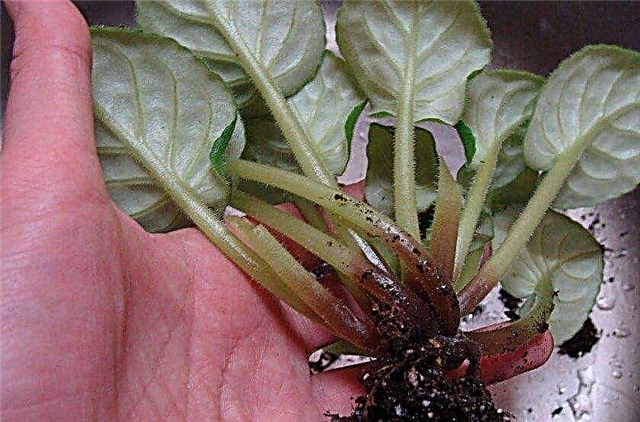
- Aphids and thrips. Microscopic sucking insects feed on the juice of a flower, which dries and dies over time. Insects are destroyed by the Agravertin preparation, sprayed with a solution of 2 ml / 1 liter of water.

- Shield - sucking pest with a gray-brown shield on the back. Effective against the insect is the drug "Actara", sprayed with a solution of 1 g / 1.25 l of water.







